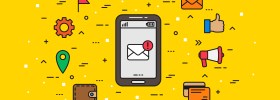It seems that so much of what we’ve heard about the Internet of Things (IoT) – devices and sensors that share information over the internet – revolves around household objects that for decades have been considered virtually inanimate: bathroom scales, fridges, ovens and so on.
That’s led to some ridicule. Is it really a huge leap forward for my fridge to be able to tell me that it’s running low on something? Can’t I just open the door and check? In fact, it feels a little creepy to have my smart-fridge interfering in my life like that.
I can only imagine the alerts I’d get!
“Hey, Steve. After consuming four beers last night your supply is down to just one. I will add six more to the shopping list. Actually, on second thoughts, I won’t. I saw your bathroom scale’s latest update, and it doesn’t look pretty. Less beer, more salad.”
That may be a slightly exaggerated version of what a connected fridge would do, and I’m sure that plenty of people out there would find this kind of interaction very valuable. But the truth is, of course, that home devices make up just a very small part of IoT’s potential.
It is potential that could result in a multi-billion dollar industry over the next few years. Industry analysts Gartner claim that 4.9 billion connected devices will be in use in 2015, up 30% on 2014’s figures. By 2020, Gartner thinks there will be 25 billion devices connected.
That actually seems a conservative estimate compared to what others are suggesting; Cisco, for example, thinks we will hit that 25 billion figure in 2015 and by 2020 there will be 50 billion connected devices.
Not all of those devices will be fridges and thermostats and so on
They will be smart devices that humans will have much less interaction with; devices that will communicate with each other to make our lives just that little bit easier.
In fact, that’s where the Internet of Things began its life, many, many years back. Machine 2 Machine (M2M) communications have been around for ages – devices that share information and take action without a human being involved. Take baggage systems at airports, for example. Once the bag is loaded onto the system it uses RFID to zip around the airport to where it can be loaded on to the plane, with no person involved in the process except for the very beginning and the very end.
That’s the basis of IoT. The real uses for it will be things that don’t directly involve us but will benefit us. Connected cars will communicate with sensors placed across a city, advising drivers to adjust their speed to help them to hit traffic lights at green or take an alternative route if traffic is heavy. Sensors on the car can monitor tire pressure, the engine and countless other parts and alert the driver before the issue becomes dangerous.
If the IoT can control how we drive our cars and help us stay ahead of any potential problems, car ownership will become cheaper and driving will become more efficient, which can reduce emissions. That equals benefits for our wallets and the environment. Connected cars are set to be a big part of the IoT. That Gartner research I mentioned above also says that by 2020 there will be 250 million smart cars on the roads.
The IoT could also help reduce costs within the home
Anyone who has suffered a water leak will know how much pain they can cause. Leaks within a property can go undetected for a long time and the cost of the lost water and repairs can be huge. Sensors can detect leaks and alert the homeowner, so repairs can start before real damage is done.
The potential for IoT really is unlimited: from every appliance in your home to lightbulbs to your car to rubbish bins to wearable devices to medical devices to postal and delivery services to street lights to farming, there are very few industries that will not be touched by IoT.
And while most of it will not need us to get too heavily involved, we will feel the benefit… even if it is just my fridge telling me to lay off the beer.









